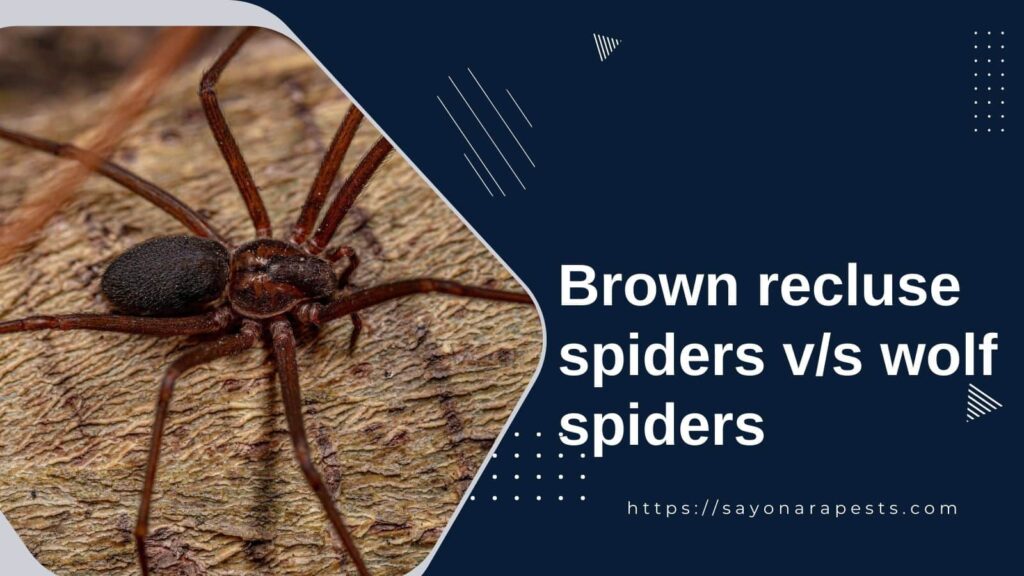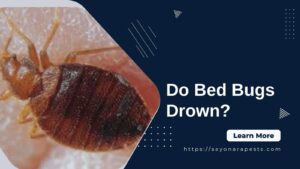Wolf spiders and brown recluse spiders are two of North America’s most commonly encountered spiders.
Despite their prevalence, many people don’t know the difference between the two species.
In this post, we’ll take a closer look at both types of spiders and highlight some of their fundamental differences.
We’ll also explore tips for dealing with spider infestations safely and effectively. So without further ado, let’s get started!
The physical differences between brown recluse spiders and wolf spiders.
Brown recluse spiders are tiny brown spiders with distinctive violin-shaped marks on their back. They grow about 1/4 to 1/2 an inch in length and are typically found in the southern and Midwestern United States.
Wolf spiders, on the other hand, are more enormous spiders that can grow to be over an inch in length. They’re usually dark brown or black, with various markings on their bodies. You’ll find them all across the United States.
The habitat differences between brown recluse spiders and wolf spiders.
Brown recluse spiders are typically found in dark, secluded areas like basements, attics, and crawlspaces. They like to build their webs in these areas and generally only come out at night to hunt for food.
Wolf spiders, on the other hand, don’t build webs. Instead, they actively hunt down their prey. You’ll often find them near light sources, like windows and doors. This is because they’re attracted to the insects drawn to these light sources.
The behavioral differences between brown recluse spiders and wolf spiders.
The most notable behavioral difference between brown recluses and wolf spiders is that brown recluses are more likely to bite humans. This is because they’re shy, reclusive creatures that only bite when they feel threatened.
Wolf spiders, on the other hand, are not shy and rarely bite humans unless provoked. If you get bitten by a wolf spider, it likely won’t be any more severe than a bee sting.
The difference in the venom of brown recluse and wolf spiders.
All spiders produce venom, but the venom of brown recluse spiders is more potent and dangerous to humans. A bite from a brown recluse spider can result in serious health complications, including necrosis (tissue death) and organ damage.
Wolf spider bites, while painful, are not generally considered dangerous to humans. In most cases, the symptoms of a wolf spider bite will resolve within a few days.
How to deal with brown recluse spiders and wolf spiders?
You must call a professional pest control company for help if you have a brown recluse spider infestation. These spiders can be difficult to control and eliminate on your own, and their bites can be very dangerous.
If you have a wolf spider infestation, on the other hand, you may be able to deal with it yourself. Begin by sealing up any cracks or openings in your home that these spiders could use to get inside. Then, vacuum up any spiders you see. You can also set out traps baited with spider attractants to help reduce the population.
Both brown recluse spiders and wolf spiders can be dangerous, so it’s essential to know how to identify them and how to deal with them safely. You can keep your home safe from harm by familiarizing yourself with the key differences between these two types of spiders.
How to identify a brown recluse spider?
As we mentioned, brown recluse spiders are tiny brown spiders with distinctive violin-shaped marks on their back. They’re usually found in the southern and Midwestern United States.
If you think you’ve spotted a brown recluse spider, it’s essential to be sure before taking action. These spiders can be challenging to identify, even for experts. The best way to be sure is to catch the spider and bring it to a local Extension office or pest control company for identification.
You must call a professional pest control company for help if you have a brown recluse spider infestation. These spiders can be difficult to control and eliminate on your own, and their bites can be very dangerous.
How to identify a wolf spider?
Wolf spiders are giant, hairy spiders that can be brown, gray, or black. They’re found worldwide and are common in the United States.
If you think you’ve spotted a wolf spider, the best way to be sure is to catch it and bring it to a local Extension office or pest control company for identification.
If you have a wolf spider infestation, you may be able to deal with it yourself. Begin by sealing up any cracks or openings in your home that these spiders could use to get inside. Then, vacuum up any spiders you see. You can also set out traps baited with spider attractants to help reduce the population.
How to avoid contact with brown recluse spiders and wolf spiders?
The best way to avoid contact with brown recluse spiders and wolf spiders is to be familiar with their habitats and behaviors.
Brown recluse spiders are shy, reclusive creatures that only bite when they feel threatened. They’re most commonly found in the southern and Midwestern United States. To avoid contact with these spiders, be careful when handling boxes or other objects stored in these areas.
Wolf spiders, on the other hand, are not shy and will bite if they feel threatened. These spiders are found worldwide and are common in the United States. To avoid contact with these spiders, be careful when handling boxes or other objects stored in these areas.
Both spiders can be dangerous, so know how to identify and avoid contact with them. Keep your home safe by familiarizing yourself with the above critical differences between them.
Brown recluse spiders and wolf spiders may look similar, but they have several physical and behavioral differences that can help you identify them.
The venom of brown recluse spiders is more potent than the venom of wolf spiders, so it’s essential to be able to tell them apart to take appropriate action if you encounter one.
Knowing how to avoid contact with both types of spiders is essential for keeping yourself and your loved ones safe.
Have you ever seen a brown recluse spider or a wolf spider?











